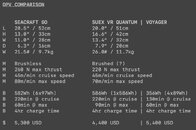Sorry for the delay in direct responses, we were entertaining out of town divers last week. I appreciate your feedback.Quieter is definitely an advantage - to me. I don't think I have ever heard anyone say "I wish my scooter were louder."
Having a cruise control is definitely nice. I thought the Go! had some way in its menus or a click combo to allow it to run with the trigger "locked", but I could be wrong. Regardless, it does not seem like a difficult problem to solve to fabricate some kind of simple thing to hold the trigger, if needed.
You talked about motor power lag and are attributing lag in the Go! to having a brushless motor. I don't think those are related.
A brushless motor seems like a clear advantage and undoubtedly contributes to the Go! having a longer run time.
Lag in delivery seems likely to be a designed-in characteristic of the Go!'s motor controller and firmware. It may even be adjustable. Seacraft puts a lot of stuff in their menu system to support changing the behavior of their scooters (in general - not sure exactly how they have the Go! setup).
What is your basis for saying the Suex has better or more robust construction? I know the Go! had one specific issue when they first came out where you could overtighten some part on the nose and break something. But, I believe they redesigned that and that problem is now gone. I haven't heard of other issues with the Go! lacking robustness. From what I know, Seacraft and Suex both produce very high quality DPVs.
Call 'em crazy, but the shop that conducts my cave and tech training prefer louder scooters for team expeditions. YMMV. I'm not sure it would be better for me. Wildlife didn't seem to be too disturbed by the Suex XJ I trained on, unless I changed speeds. The sudden change in pitch appeared to freak the fish out a bit.
In reading through the Go usage instructions (Usage instructions – Seacraft Support Website) it does not appear there is any function to lock the trigger. A simple rubber band (EPDM 2-Inch Loop) might serve. A little ghetto, but might do the trick. I've got a bit of arthritis in my hands and wrists so a trigger lock may be a bigger deal to me than some.
After reading a bit more I agree, lag in delivery does not appear to be a function of a brushless motor. I am not optimistic that I would be able to modify the Go's behavior though (I'm not a big fan of probably or maybe). The slow ramp up to speed isn't particularly appealing to me, but I'm not a cross section of the population.
My comments regarding the construction comes from my own reading and observation so far based on limited information and anecdotes, and could be entirely off, so don't quote me. Looking at pictures side by side, and knowing what I do about Suex, if I were a betting man I'd bet on Suex to be a bit more stout, but it also weighs about five more pounds. Pros and cons.
I'm hoping to go over to Playa del Carmen later this week to dive a Seacraft of some form or another. No Go's down here for tryout at this time. I will work to try out each specific unit before I buy. By the time my path crosses a Suex Voyager I will likely by back home in the Pacific Northwest, and I'm unlikely to get drysuit certification just to take one for a spin. If I'm going with a Voyager it will be purchased through 8 Diving just south of Seattle. If it's a Go I'm not sure who I'm buying it from. These DPVs will be largely used in Cozumel where my wife and I live in the wintertime, and then occasional use on other dive trips, which is why the Voyager is in consideration. If we do go with Suex, it's likely we'll also buy the Quantum heads in Mexico, and use the Voyager heads when we travel. Service options down here are ProTec for Seacraft and Zero Gravity for Suex.people do note that the Seacraft's trigger and the lag are friction points. @bradStyle mentions Voyager - the travel version of the scooter with a smaller battery. That is, in part, why it has a lower runtime.
@bradStyle - do you have an option to try both scooters? Do you plan to travel with DPVs? What dealers / support do you have for the scooters in your area? Other points to consider:
- Trigger locks may lead to issues when you need to unlock and cannot for some reason. I have one on my SUEX but never use it.
- Brushless motors are more effective in general and the "lag" may be seen as a disadvantage or advantage depending on the diving you do and how long you plan to keep the scooter. Brushes on motors must be replaced at some point, but it is not the end of the game.
- Max speed becomes irrelevant at some point. There is only so muc thrust you need.
- Noise can be a benefit in some conditions where you need buddy awareness.
I'm already familiar with Suex's trigger system and like it. A trigger lock is important to me as I've got some hand a wrist issues.
In talking to my instructors, they mention pros and cons of brushed v brushless which include that brushless involves more electronic components, which they view as its own *potential* disadvantage, maybe balancing out the disadvantage that brushes need replacement at some point too. I'm too new to this game to have an opinion there yet.
Thanks for the input.




